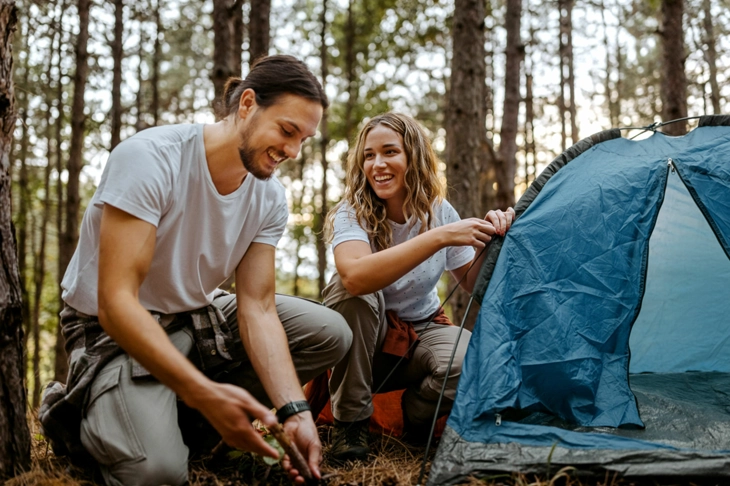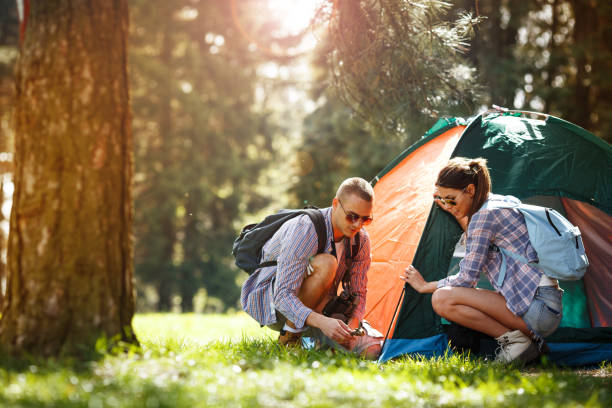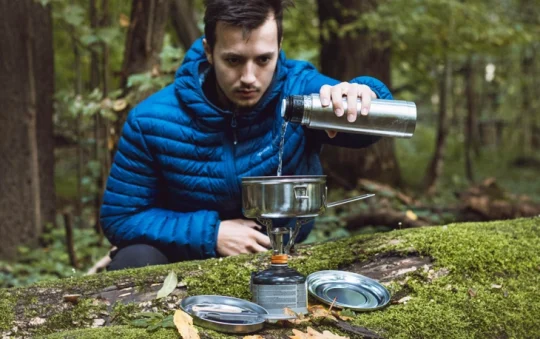This guide will help you learn how to pack your tent into your backpack effectively. This way, your tent will be easy to access and set up during your camping trips.
For people who enjoy hiking and camping, how you pack your backpack is important. How you pack your tent is a big part of this. Packing your tent correctly not only makes it fit well in your backpack but also makes setting up and taking down your campsite easier.
In the world of backpacking, making the most of the limited space in your backpack is really important. Packing your tent in a way that’s small and light is crucial. It saves space and keeps your tent handy.
This technique makes your wilderness adventure better and less complicated. When you pack your tent, you want to find the right balance between making it small and easy to get to.
First, lay out all your tent parts to make sure you have everything – the tent body, rainfly, poles, and stakes. Then, fold or roll the tent body and rainfly tightly to get all the air out.
Some people like rolling their tent because it’s more compact, while others find folding it quicker and easier. Once your tent and rainfly are packed nicely, decide where they should go in your backpack. The best spot should be stable and easy to reach.
Usually, it’s good to put the tent in the middle or lower part of the backpack, depending on your pack’s design and your other gear. The goal is to have a load that stays stable and doesn’t move around, which makes hiking more comfortable.
For the tent poles and stakes, use any side pockets or special compartments in your backpack if they’re available. This keeps these items safe and also protects the tent and your other stuff from damage.
If your backpack doesn’t have these compartments, securely attach the poles and stakes to the sides of your pack. Make sure they’re strapped in tightly and not sticking out in a way that could catch on things outside. How you pack your tent really matters for your overall backpacking experience.
A well-packed tent saves space and makes setting up your campsite easier. With practice, you’ll figure out the best way to pack your tent that suits your needs, making your outdoor adventures efficient, convenient, and comfortable.
Choosing the Right Backpacking Tent
When it comes to backpacking, picking the perfect tent is a big decision that can make a big difference in your adventure. You want tents that are light and small, so they don’t add too much weight or bulk to your backpack.
Think about what you need in a tent. Consider how many people it should fit, how tough it is against different weather, and how easy it is to set up.
Think about the number of people you’ll camp with, the kind of weather you’ll face, and the type of ground you’ll camp on. Backpackers often like tents made of strong but light materials like nylon or polyester. These materials cut down on the weight and size of your backpack while still being durable.
Taking Down and Packing Your Tent Efficiently
Taking down and packing your tent needs care and precision. Start by carefully pulling the stakes out of the ground and, if needed, remove the rain cover from your tent.
Then, fold up the tent poles carefully, keeping them away from the tent fabric to prevent damage. How you handle the tent fabric – whether you roll it or fold it – is really important.
This step helps keep the fabric in good shape and avoids long-term damage like creases or wrinkles that can weaken it.
Mastering Tent Packing: Rolling vs. Folding
Deciding how to pack your tent comes down to choosing between rolling or folding, and each has its advantages. Rolling is a popular choice because it usually makes a small and tight bundle that doesn’t crease the fabric.
To roll your tent properly, start at one end and roll it up tightly towards the other end, making sure the fabric stays stretched out to avoid any sagging or loose parts.
On the other hand, if you prefer folding, do it carefully and neatly. Folding your tent aims to make it small while keeping the fabric in good condition. A well-folded tent can be just as space-saving as a rolled one and fits nicely in your backpack.
Protecting Your Tent in Your Backpack
Once you’ve rolled or folded your tent, it’s important to put it in a special bag or stuff sack. This extra layer of protection keeps your tent safe from tears or holes while it’s in your backpack.
Choose a bag or sack that fits your tent just right, not too tight that it squishes the fabric. This helps keep your tent in good shape for many more backpacking trips.
Taking Care of Your Tent Poles
Being careful with your tent poles is really important to make sure your tent lasts a long time. When you pack your tent, make sure to keep the poles separate to avoid any damage.
Fold the poles carefully and tie them together with the cord that came with them or with an elastic band for extra security. When you pack your tent, find a good place for these poles inside your backpack. You can also attach them on the outside of your backpack for easier access.
Make sure they’re tightly secured so they don’t get tangled or caught on things outside during your trip. Being organized and thoughtful in how you pack your tent, especially the poles, helps protect them and makes your tent last longer.
Keeping Your Tent Stakes Safe
Even though tent stakes may seem small, they’re really important for keeping your tent steady. To make sure you don’t lose them or accidentally damage other things in your backpack, it’s a good idea to keep them in a small bag or a special stuff sack.
You can attach this sack to the outside of your backpack or put it in a pocket where you can easily get to it. This careful storage of tent stakes not only keeps them safe but also makes your backpack neat and protects your stuff.
Storing Your Tent’s Rainfly Properly
If your tent has a rainfly, it’s important to store it the right way. You can either fold it nicely or roll it up tight, and then put it in a separate part of your backpack.
This helps prevent any damage from it rubbing against other things or touching sharp objects in your pack. Storing the rainfly correctly keeps it in good shape and makes sure it keeps you dry in bad weather.
Strategic Tent Packing in Your Backpack
When you put your tent in your backpack, you need to plan it out carefully. The goal is to find the right spot where it not only fits but also helps balance the weight.
A good way to do this is to place the tent close to your back. This can make carrying your backpack more comfortable, especially on long hikes.
Making Sure the Weight is Even in Your Backpack
Having the weight evenly spread in your backpack is really important for a comfy hiking trip. Heavier stuff should be near your back and in the middle of the pack.
This helps keep everything stable and reduces strain on your shoulders and back. Making sure your tent and other gear are evenly distributed makes your backpack balanced and comfortable.
More Tips for Packing Your Tent
Adjust for the Weather: Change how you pack based on the expected weather. If it might rain, it’s smart to pack extra rain gear or a tent footprint for more protection.
Keep it Dry: Think about getting a waterproof bag for your tent and rain cover. This gives extra protection against moisture.
Save Space: Use compression straps or packing cubes to use space efficiently and keep your pack organized.
Prepare Before You Go: Practice packing and unpacking your tent before your trip. This can save you time and trouble when you’re actually camping.
Take Care of Your Tent: Regularly check and maintain your tent. This helps prevent damage and keeps your tent working well for many trips.
In Conclusion
As you’ve learned in this guide, mastering the art of packing a tent in your backpack can greatly enhance your outdoor adventures. It’s a skill that not only saves space but also ensures the safety and accessibility of your tent during your trips.
But packing is just one piece of the puzzle. To complete your outdoor gear setup, consider exploring our comprehensive guide on the ‘5 Best Backpacking Tents of 2024.’ It offers insights into the top tents available this year, each designed to cater to different preferences and needs.
With a well-packed backpack and the right tent, you’ll be well-prepared for memorable and enjoyable outdoor journeys. Happy camping!




No Responses